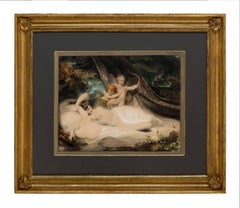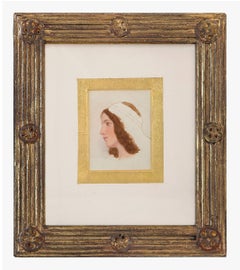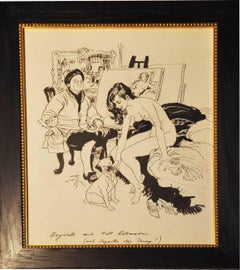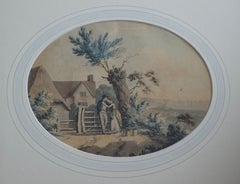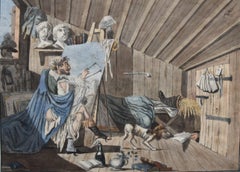Tom Rooth Fine Art Figurative Drawings and Watercolors
to
3
Overall Width
to
Overall Height
to
1
1
1
1
1
2
1
2
2
2
1
1
1
3
3
2
1
1
1
3
Venus
By Richard Westall
Located in London, GB
Richard Westall, R.A. (1765-1836)
Venus
signed and dated ‘R. Westall 1794’ (lower right)
pencil and watercolour, with white heightening
image 11 ⅞ x 15 ¼ in. (30.2 x 38.7 cm.)
frame 22 ⅛ x 26 in. (56.3 x 66.1 cm.)
Provenance:
Private Collection, UK.
Venus (1794) was produced during a highly creative and defining period of Richard Westall’s career and artistic development, when from 1790-95 the ambitious young artist was sharing a house at 57 Greek Street, Soho, with his friend Sir Thomas Lawrence, the future President of the Royal Academy.
Whilst lodging together, Lawrence became an Associate of the Royal Academy in 1791, Westall the following year, and both were elected full-members in 1794 – the year Lawrence was appointed Painter-in-Ordinary to His Majesty King George III. Westall was to become Queen Victoria’s first Drawing Master, before her ascension to the throne.
It was in this very year, 1794 - as the two young artists became Royal Academicians - that the present watercolour was executed, and it is exciting to speculate that Lawrence would have examined and given his thoughts on the work.
Highly comparable to The Wallace Collection’s Nymph and cupids (c.1793, cat. P757), acquired by Francis Seymour-Conway (1777-1842), 3rd Marquess of Hertford, (who hung it in his bedroom), the mid-1790s saw Westall exhibiting and returning to similar subject-matter on a number of occasions. Two works with titles that could be applied to the present picture were exhibited at the Royal Academy, in 1794 (no. 341 Nymph and Cupids) and 1795 (no. 620, A Wood–nymph and Cupids). However, a print after the watercolour, engraved by F. Screen, entitles the piece Venus.
Westall is regarded as a great virtuoso watercolourist, and Venus is evidence of the young artist’s mastery of the medium. Indeed, it is unusual to find a watercolour of comparable age so well preserved, and retaining such vibrancy - the superb condition providing an insight into his exceptional brushwork and use of colour.
Venus languishes luxuriously on her woodland bed, the trunk of a tree resembling a curtain, while three winged putti play beside her, seeming to gesture to someone in the woods. Cupid draws back his bow and aims an arrow of love, perhaps about to pierce the heart of a hunting nobleman, or unsuspecting woodcutter. The striking contrast between the almost luminescent nymph, with the deep, rich, luxuriant forest, gives the glade an alluring sense of mystery – perhaps an allusion to the mysteries of the heart, a pre-occupation with Romanticism, central to the emerging thought of the time. Westall can be classified as one of the great Romantic artists, and even painted Lord Byron’s portrait...
Category
1790s Romantic Figurative Drawings and Watercolors
Materials
Watercolor, Pencil
A young beauty
By George Lawrence Bulleid
Located in London, GB
George Lawrence Bulleid (1858-1933)
A young beauty
pencil and watercolour
3 ⅛ x 2 ⅜ in. (7.9 x 6 cm.)
frame 9 ⅜ x 8 ¼ in. (23.9 x 20.9 cm.)
Category
Late 19th Century Naturalistic Figurative Drawings and Watercolors
Materials
Watercolor
Artists and their muses
Located in London, GB
Playboy School, 20th Century
Artists and their muses: Titian and Violante; Sir Peter Lely and Nell Gwyn; Francois Boucher and Louise O’Murphy; Hogarth, Nell...
Category
1980s Romantic Figurative Drawings and Watercolors
Materials
Ink, Watercolor, Pencil
Related Items
English School, circa 1800 Georgian watercolor, The Sailor's return
Located in Harkstead, GB
A delightful rustic scene dating to circa 1800 with the sailor returning to his thankful wife and the domestic idyll of his country cottage. The harbour with sailing ships ferrying c...
Category
Early 19th Century Romantic Figurative Drawings and Watercolors
Materials
Watercolor, Laid Paper
H 6.5 in W 8.5 in D 1 in
France 19th century, The Bohème artist in his workshop, watercolor
Located in Paris, FR
France circa 1850
The Bohème artist in his workshop
Watercolor on paper
15.5 x 21.5 cm
In good condition except a small tear (visible on the photographs) on the upper right border.
I...
Category
1840s Romantic Interior Drawings and Watercolors
Materials
Watercolor
Life study of a male nude in repose - European School, late 18th Century
Located in Middletown, NY
European School, late 18th century. Red chalk with primo pensiero in graphite on cream laid paper, 8 1/2 x 11 1/2 inches (215 x 293 mm). Scattered light handling wear and multiple s...
Category
Late 18th Century Naturalistic Nude Drawings and Watercolors
Materials
Chalk, Laid Paper, Pencil, Graphite
Watercolor The Garden at Sickelsjö, 1883
Located in Stockholm, SE
We are delighted to present a stunning watercolor by the Swedish artist Albert Theodor Gellerstedt. This artwork, titled "Sickelsjö Trädgård" was created on June 8, 1883. The paintin...
Category
1880s Romantic Landscape Drawings and Watercolors
Materials
Paper, Watercolor
Louis Gallait (1810-1887) Portrait of a Gentleman, watercolor and gouache
By Louis Gallait
Located in Paris, FR
Louis Gallait (1810-1887)
Portrait of a Gentleman,
Watercolor and gouache on paper, square white lines,
24 x 16 cm
Stamp of the Louis Gallait Estate on the mount on the lower righ...
Category
1850s Romantic Portrait Drawings and Watercolors
Materials
Watercolor, Gouache
George H Hay, Spinning Wool, Watercolour
Located in Cheltenham, GB
This late 19th-century watercolour by Scottish artist George H Hay RSA (1831-1912) depicts four young ladies, wearing outfits synonymous with the 1820s, spinning wool within a simple...
Category
1890s Romantic Figurative Drawings and Watercolors
Materials
Paper, Watercolor
Auguste Mayer (1805-1890) A seascape with a boat, signed drawing
Located in Paris, FR
Auguste Mayer (1803-1890
A seascape with a boat
signed with the initials on the lower left
Pencil and heightenings of white gouache on paper
17.5 x 26 cm...
Category
1860s Romantic Landscape Drawings and Watercolors
Materials
Gouache, Carbon Pencil
French School 19th Century, Portrait of a dandy, watercolor on paper
Located in Paris, FR
French School 19th Century,
Portrait of a dandy,
watercolor on paper
19 x 13 cm
Signed (?) with pencil lower right "L ... " illegible
Framed : 29 x 23 cm
Category
1880s Romantic Portrait Drawings and Watercolors
Materials
Watercolor
Horse with Herds - China Ink Drawing by Filippo Palizzi - 1895
By Filippo Palizzi
Located in Roma, IT
Image dimensions: 14x22 cm.
Horse with Herds is a really beautiful china ink original drawing on paper, signed and dated in black ink on lower margin by the Italian artist, Filippo Palizzi...
Category
1890s Naturalistic Animal Drawings and Watercolors
Materials
Ink
H 12.21 in W 15.28 in D 0.67 in
Jules-Eugène Lenepveu (1819-1898) Portrait of a man in profile, signed drawing
Located in Paris, FR
Jules-Eugène Lenepveu (1819-1898)
Portrait of a man in profile
signed on the lower right
Pencil and heightenings of white gouache on paper
19.5 x 13 cm
Framed : 29 x 22.7 cm
Jules-Eugène Lenepveu is of course particularly well known for his large-scale paintings, such as the one on the ceiling of the Paris Opera, but his work here is much more delicate and intimate. We recognise the artist's mastery of talent, but the play of textures, with its highlights of white that enliven and illuminate the model's face, is also very subtle.
There's a particularly charming sense of life and impression of light.
Jules-Eugène Lenepveu was born in Angers on 12 December 1819, on the site of the street that now bears his name, into a family of small shopkeepers. The painter showed a deep attachment to his family throughout his life through his correspondence and the many portraits of his relatives.
He entered the drawing school in Angers in 1833, where he was a pupil of Jean-Michel Mercier. There he rubbed shoulders with the sculptor Ferdinand Taluet. He arrived in Paris in 1837 and entered the Beaux-Arts, where he was officially admitted to François-Édouard Picot's studio in 1838. He exhibited his work "L'Idylle" at the Salon of 1843 and, that same year, left for his first visit to Italy. He was awarded the Second Prix de Rome in 1843 for "Cincinnatus recevant les députés du Sénat" (Cincinnatus receiving the deputies of the Senate), then the First Prize in 1847 for "La Mort de Vitellius" (The Death of Vitellius).
A resident at the Villa Médicis from 1848, he was surrounded by painters Alexandre Cabanel, Léon Benouville, Gustave Boulanger, Félix Barrias...
Category
1860s Romantic Portrait Drawings and Watercolors
Materials
Gouache, Pencil
James Ward The Fisherman's Family
By James Ward
Located in Saint Amans des cots, FR
Precious Watercolor attributed to James WARD (1769-1859) - England, 1830-1840. The Fisherman' S Family. Measurements : View : 20"x14.6" (51x37 cm), With frame : 26.6"x21.5" (67.5x54....
Category
1830s Romantic Figurative Drawings and Watercolors
Materials
Paper, Watercolor
Whimsical Illustration Skiing Cartoon, 1938 Mt Tremblant Ski Lodge William Steig
By William Steig (b.1907)
Located in Surfside, FL
Lighthearted Illustration of Outdoor Pursuits This one being a Skiing scene, a boy and a girl on skis. signed W. Steig
Provenance: from Mrs. Joseph B. Ryan, Commissioned by Joe Ryan for the bar at his ski resort, Mount Tremblant Lodge, in 1938.
Mont Tremblant, P.Q., Canada
Watercolor and ink on illustration board, sights sizes 8 1/2 x 16 1/2 in., framed.
In 1938 Joe Ryan, described as a millionaire from Philadelphia, bushwhacked his way to the summit of Mont Tremblant and was inspired to create a world class ski resort at the site. In 1939 he opened the Mont Tremblant Lodge, which remains part of the Pedestrian Village today. This original illustration is on Whatman Illustration board. the board measures 14 X 22 inches. label from McClees Galleries, Philadelphia, on the frame backing paper.
William Steig, 1907 – 2003 was an American cartoonist, sculptor, and, in his later life, an illustrator and writer of children's books. Best known for the picture books Sylvester and the Magic Pebble, Abel's Island, and Doctor De Soto, he was also the creator of Shrek!, which inspired the film series of the same name. He was the U.S. nominee for both of the biennial, international Hans Christian Andersen Awards, as a children's book illustrator in 1982 and a writer in 1988.
Steig was born in Brooklyn, New York in 1907, and grew up in the Bronx. His parents were Polish-Jewish immigrants from Austria, both socialists. His father, Joseph Steig, was a house painter, and his mother, Laura Ebel Steig, was a seamstress who encouraged his artistic leanings. As a child, he dabbled in painting and was an avid reader of literature. Among other works, he was said to have been especially fascinated by Pinocchio.He graduated from Townsend Harris High School at 15 but never completed college, though he attended three, spending two years at City College of New York, three years at the National Academy of Design and a mere five days at the Yale School of Fine Arts before dropping out of each.
Hailed as the "King of Cartoons" Steig began drawing illustrations and cartoons for The New Yorker in 1930, producing more than 2,600 drawings and 117 covers for the magazine. Steig, later, when he was 61, began writing children's books. In 1968, he wrote his first children's book. He excelled here as well, and his third book, Sylvester and the Magic Pebble (1969), won the Caldecott Medal. He went on to write more than 30 children's books, including the Doctor DeSoto series, and he continued to write into his nineties. Among his other well-known works, the picture book Shrek! (1990) formed the basis for the DreamWorks Animation film Shrek (2001). After the release of Shrek 2 in 2004, Steig became the first sole-creator of an animated movie franchise that went on to generate over $1 billion from theatrical and ancillary markets after only one sequel. Along with Maurice Sendak, Saul Steinberg, Ludwig Bemelmans and Laurent de Brunhofff his is one of those rare cartoonist whose works form part of our collective cultural heritage.
In 1984, Steig's film adaptation of Doctor DeSoto directed by Michael Sporn was nominated for the Academy Award for Best Animated Short Film. As one of the most admired cartoonists of all time, Steig spent seven decades drawing for the New Yorker magazine. He touched generations of readers with his tongue–in–cheek pen–and–ink drawings, which often expressed states of mind like shame, embarrassment or anger. Later in life, Steig turned to children's books, working as both a writer and illustrator.
Steig's children's books were also wildly popular because of the crazy, complicated language he used—words like lunatic, palsied, sequestration, and cleave. Kids love the sound of those words even if they do not quite understand the meaning. Steig's descriptions were also clever. He once described a beached whale as "breaded with sand."
Throughout the course of his career, Steig compiled his cartoons and drawings into books. Some of them were published first in the New Yorker. Others were deemed too dark to be printed there. Most of these collections centered on the cold, dark psychoanalytical truth about relationships. They featured husbands and wives fighting and parents snapping at their kids. His first adult book, Man About Town, was published in 1932, followed by About People, published in 1939, which focused on social outsiders. Sick of Each Other, published in 2000, included a drawing depicting a wife holding her husband at gunpoint, saying, "Say you adore me."
According to the Los Angeles Times, fellow New Yorker artist Edward Sorel...
Category
1930s Naturalistic Figurative Drawings and Watercolors
Materials
Archival Ink, Watercolor, Illustration Board
